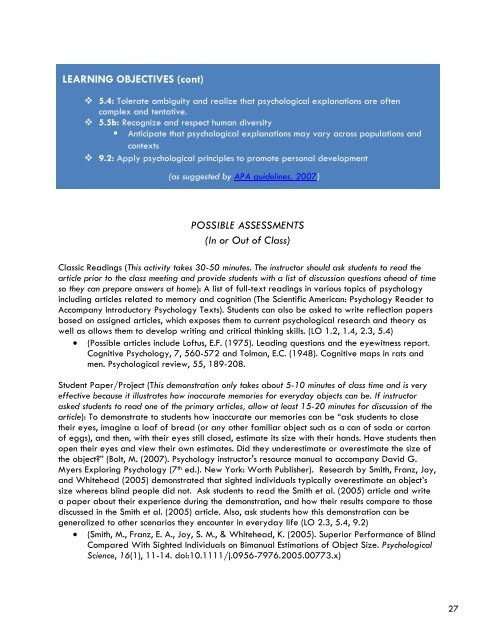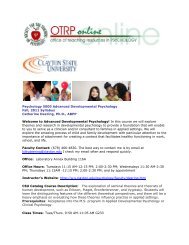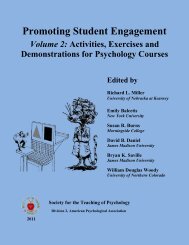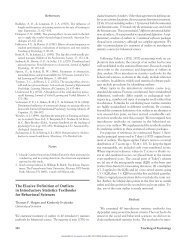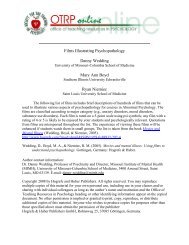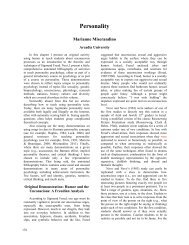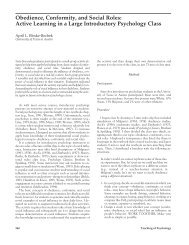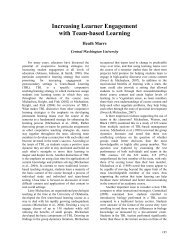INTRODUCTORY PSYCHOLOGY TEACHING PRIMER Early Career ...
INTRODUCTORY PSYCHOLOGY TEACHING PRIMER Early Career ...
INTRODUCTORY PSYCHOLOGY TEACHING PRIMER Early Career ...
You also want an ePaper? Increase the reach of your titles
YUMPU automatically turns print PDFs into web optimized ePapers that Google loves.
LEARNING OBJECTIVES (cont)<br />
5.4: Tolerate ambiguity and realize that psychological explanations are often<br />
complex and tentative.<br />
5.5b: Recognize and respect human diversity<br />
Anticipate that psychological explanations may vary across populations and<br />
contexts<br />
9.2: Apply psychological principles to promote personal development<br />
(as suggested by APA guidelines, 2007)<br />
POSSIBLE ASSESSMENTS<br />
(In or Out of Class)<br />
Classic Readings (This activity takes 30-50 minutes. The instructor should ask students to read the<br />
article prior to the class meeting and provide students with a list of discussion questions ahead of time<br />
so they can prepare answers at home): A list of full-text readings in various topics of psychology<br />
including articles related to memory and cognition (The Scientific American: Psychology Reader to<br />
Accompany Introductory Psychology Texts). Students can also be asked to write reflection papers<br />
based on assigned articles, which exposes them to current psychological research and theory as<br />
well as allows them to develop writing and critical thinking skills. (LO 1.2, 1.4, 2.3, 5.4)<br />
• (Possible articles include Loftus, E.F. (1975). Leading questions and the eyewitness report.<br />
Cognitive Psychology, 7, 560-572 and Tolman, E.C. (1948). Cognitive maps in rats and<br />
men. Psychological review, 55, 189-208.<br />
Student Paper/Project (This demonstration only takes about 5-10 minutes of class time and is very<br />
effective because it illustrates how inaccurate memories for everyday objects can be. If instructor<br />
asked students to read one of the primary articles, allow at least 15-20 minutes for discussion of the<br />
article): To demonstrate to students how inaccurate our memories can be “ask students to close<br />
their eyes, imagine a loaf of bread (or any other familiar object such as a can of soda or carton<br />
of eggs), and then, with their eyes still closed, estimate its size with their hands. Have students then<br />
open their eyes and view their own estimates. Did they underestimate or overestimate the size of<br />
the object?” (Bolt, M. (2007). Psychology instructor's resource manual to accompany David G.<br />
Myers Exploring Psychology (7 th ed.). New York: Worth Publisher). Research by Smith, Franz, Joy,<br />
and Whitehead (2005) demonstrated that sighted individuals typically overestimate an object’s<br />
size whereas blind people did not. Ask students to read the Smith et al. (2005) article and write<br />
a paper about their experience during the demonstration, and how their results compare to those<br />
discussed in the Smith et al. (2005) article. Also, ask students how this demonstration can be<br />
generalized to other scenarios they encounter in everyday life (LO 2.3, 5.4, 9.2)<br />
• (Smith, M., Franz, E. A., Joy, S. M., & Whitehead, K. (2005). Superior Performance of Blind<br />
Compared With Sighted Individuals on Bimanual Estimations of Object Size. Psychological<br />
Science, 16(1), 11-14. doi:10.1111/j.0956-7976.2005.00773.x)<br />
27


